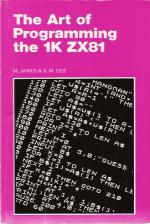
ZX Computing
 1st April 1983
1st April 1983
Categories: Review: Book
Author: James Walsh
Publisher: Babani Books
Machine: Sinclair ZX81
Published in ZX Computing #6
The Art Of Programming The 1K ZX81
Finding it difficult to do anything worthwhile in 1K RAM? Could this be the answer (Well, it is cheaper than a 16K RAM pack) - at £1.95 what have you got to lose?
OK, how about starting from the beginning. The Art Of Programming The 1K ZX81 is written by M James and SM Gee, and published by Bernard Babani Ltd. It is a thin volume of about 85 pages with a printer listing on the front and the preface written on the back! The first thing you come to inside the book is an expanded version of what is written on the back cover. The contents of the book are split up into eight chapter headings: Making the most of your ZX81 (I seem to have heard that phrase somewhere before); Randomness; Graphics; Moving graphics; PEEK and POKE; A Sense of Time; Strings and Words; and finally, Hints and tips.
It is basically aimed at the owners of ZX81s who have mastered the basic operations of plugging it in and turning it on, but have had limited success with the manual itself. A frightened yelp from the dog as he hurriedly ducked to avoid a hurtling copy of the ZX manual reminded me of the ideal person to read the book (no, not the dog, he's more into Hi-res graphics) - my younger brother who had always been keen to learn but had found the Sinclair manual the major stumbling block.
Well, I thought, at least this book is a little thinner and less likely to knock the dog unconcious, so how about giving it a try. After some long, quiet evenings and many a mile of printer paper with 'BMX' printed on it, there were a number of interesting observations he came up with.
Though the book was written for the complete novice, rather much was presumed as far as previous experience was concerned. Though some of the functions such as RAND were well explained, some functions were not looked into in enough detail, and gave cause for concern, when it came to the programs themselves.
Though the programs were quite good, they were in some ways too good and lost the reader, leaving him with major doubts. Poor explanations were given for some of the programs, which meant that the reader was often left with the feeling that they did not, in fact, work!
I was quite amused by one comment in the first chapter explaining how the ZX81 is the successor to Sinclair's first handheld computer, the ZX80. I have heard the Sinclair ZX80 being called many a name, but never 'handheld'!!!
Though the book sets out quite admirably, it leaves some gaps, and, in fact, goes too far too fast. Maybe with a little more time and twice as many pages, it could turn out to be a better book. But time is something that we do have, as already they have lost much of their market in Britain with the introduction of the Spectrum.
All things considered if money is short and the manual is used in conjunction with this book, then it would make a quite reasonable combination.
The Art Of Programming The 1K ZX81, published by Bernard Babani, is written by M James and SM Gee and is priced at £1.95. ISBN 0-85934-084-8.
Scores
Sinclair ZX81 Version| Overall | 70% |
Scores
Sinclair ZX81 Version| Overall | 70% |


